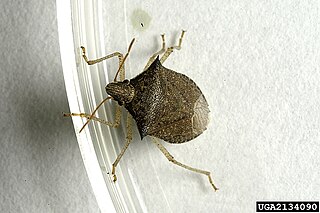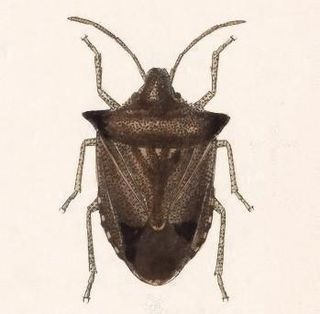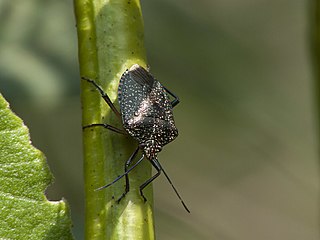
Euschistus quadrator is a species in the family Pentatomidae, in the order Hemiptera . The distribution range of Euschistus quadrator includes Central America and North America.
Glaenocorisa propinqua is a species in the family Corixidae, in the order Hemiptera . The distribution range of Glaenocorisa propinqua includes Europe, Northern Asia, and North America. It can be found in lakes, and its distribution is influenced by the presence of fish, which prey upon the larvae.
Phytocoris antennalis is a species in the family Miridae, in the order Hemiptera . It is found in North America.

Neacoryphus bicrucis is a species in the family Lygaeidae, in the order Hemiptera. The species is known generally as the "whitecrossed seed bug" or "ragwort seed bug". The distribution range of Neacoryphus bicrucis includes Central America, North America, Oceania, and South America.
Acalypta elegans is a species in the family Tingidae, in the order Hemiptera . The distribution range of Acalypta elegans includes Europe, Northern Asia, and North America.
Stictopleurus punctiventris is a species in the family Rhopalidae, in the order Hemiptera . The distribution range of Stictopleurus punctiventris includes Central America and North America.
Rhagovelia choreutes is a species in the infraorder Gerromorpha, in the order Hemiptera . The distribution range of Rhagovelia choreutes includes Central America and North America.
Lygus abroniae is a species in the family Miridae, in the order Hemiptera . It is found in North America.
Phytocoris fenestratus is a species of plant bugs in the family Miridae. It is found in North America.

Plagiognathus is a genus of plant bugs in the family Miridae. There are at least 110 described species in Plagiognathus.

Chelinidea tabulata is a species of leaf-footed bugs in the family Coreidae. It is found in Central America, North America, and South America.

Euschistus is a genus of stink bugs in the family Pentatomidae. There are at least 20 described species in Euschistus.
Ischnodemus conicus is a species of true bug in the family Blissidae. It is found in North America.
Pilophorus discretus is a species of plant bug in the family Miridae. It is found in Central America and North America.
Phytocoris exemplus is a species of plant bug in the family Miridae. It is found in North America.

Ischnodemus falicus is a species of true bug in the family Blissidae. It is found in North America.
Alydus tomentosus is a species of broad-headed bug in the family Alydidae. It is found in North America.

Pellaea is a genus of stink bugs in the family Pentatomidae. There is at least one described species in Pellaea, P. stictica.
Tropidosteptes geminus is a species of plant bug in the family Miridae. It is found in North America.
Xylocoris californicus is a species of bugs in the family Lyctocoridae. It is found in North America.







